- Ravana offering his nine heads to Shiva
Cave 16 (Kailasa) at Ellora.
Ravana, a great devotee of Shiva is doing severe penance to get 'Atma Linga' from Shiva so that his mother Kaikeshi could pray. Not getting any response initially from Shiva, Ravana cuts off his heads one by one. When he was about to offer the last head, Shiva appears and concedes his request.
Ravana's heads are supposed to represent his intimate knowledge of the six Shastras and the four Vedas.
Another belief is that the heads symbolize the ten senses and emotions viz. Kaama (lust) Krodha (anger) Moha (delusion) Lobha (greed) Mada (pride) Maatsarya (envy) Manas (the mind) Buddhi (intellect) Chitta (will), and Ahamkara (ego)
Other Ravana tales:








